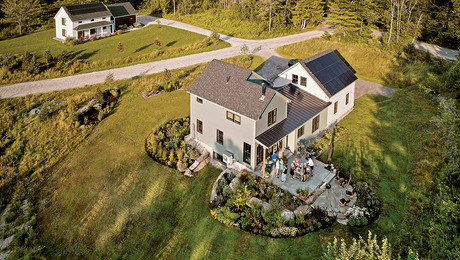My wife and I are dreaming about building a post-and-beam house on a lovely piece of land generously given to us by her family. The site is private and spectacular and is blessed with plenty of mature white pines. Several of the pines (110’+) stand on the neighbor’s land and endanger his driveway. He’s offered them to me if I’ll undertake the cost of felling and hauling them. This is a generous offer, since there’s probably 1000bf of prime timber per tree.
Here’s the problem: Finances are a bit sketchy at the moment. I’m a general contractor in a large eastern city six hours from the property and am weathering (as best I can) this econimic slowdown. Should I go ahead and hire the sawyer now, relieving my neighbor of his hazard and enhancing my lumber resource; if so, shouldn’t I have the rest of the timber (on our property) for the future house, felled at the same time, finances permitting? The milling could be done on or off-site and stickered under a temporary shed, ready for the project whenever the economy begins to turn around and finances become more secure. What say you?



















Replies
As long as the lumber is stacked, stickered, and sheltered it will last indefinitely. The worst that would happen is that it would turn a bit grey, but a touch of Oxalic acid will take care of that.
The only issue I can think of is how you will have it milled. Do you have enough of a sense of what you want to build in order to plan what dimensions you'll need?
Scott.
Edited 10/12/2009 12:28 pm by Scott
I appreciate your input, Scott. And no, we haven't settled on a design yet, but that's obviously the first step if we decide to fell now. In that regard we're looking at small, "green" house ideas found here, and post-and-beam design resources. Any recommendations would be welcome.
>>>Any recommendations would be welcome.No idea there, sorry. Perhaps the others know about this.I would think the timber frame or post and beam world has some basic standards. Hopefully you can have the logs milled into a standard dimension and then worry about all the cross cutting and joinery later.Good luck, sounds like an exciting project.Scott.
I'd do my best to cut the timber while the neighbor is offering and cooperative. A good timber man may be able to fell your trees in exchange for a quantity of smaller trees plus the tops of the big trees. You won't be able to use much past the 10 inch diameter point.
A woodmizer sawmill can get you to the dimensional timbers that you want. If there's any way to go ahead and place a "shop slab" for future use, maybe 24 x 36, that would be a great place to dry the wood.
Two caveats; USE DRY STICKERS, not green scraps. The green stickers will stain the wood deeply. Don't ask me how I know. #2, find some way to treat for powder post beetles. There are fumigants that are very toxic, you would have to "tent" the pile of stickered wood, but do consult with someone on this matter - you don't want to go to go to all this trouble and expense only to have an infestation in your timber frame or unuseable wood.
Greg
Edited 10/12/2009 12:50 pm ET by GregGibson
Don't spend money that you can't afford. It's going to get worse before it gets better.
You may be right. And here comes winter.
I ran over some old lady one night at the county fair, but I didn't get arrested because my dads the mayor.
"Should I go ahead and hire the sawyer now, relieving my neighbor of his hazard and enhancing my lumber resource"
yes, as long as the $ issue doesn't endanger your financial well being - the offer is on the table now, no guarentee about the future -
"shouldn't I have the rest of the timber (on our property) for the future house, felled at the same time, finances permitting?"
I don't think I would since you don't have a plan/materials list -
check with a sawyer or three - see if someone will do the job on the shares - no money out of your pocket -
for a timber frame you'll have the main structural members which will probably be 8"X8" or smaller, and secondary structural wood - nailers and purlins and such, likely to be 4"X4" or so - and floor framing - 2 or 3X10s or so - - sheathing and siding and flooring - likely to 1" -
so - saw a bunch of maybe 9"X9" sticks, and some 4X4 stuff, and then when you have your plan, have the sawyer back to resaw to specs and cut the rest of the timber needed from the property -
the outside of the logs yield the best/clearest lumber, the heart contains lots of knots - beams cut that contain the pith will check more severely than beams that don't - beams that don't contain the pith will deform from square as they dry -
common tow behind mills are limited to 20' or less in length - long enough for a modest cabin, but may be shorter than you want for some structures -
good advice on stacking and stickering has already been given - powder post beetles are a problem with cool/damp stacks - probably no issue in new stacks for one warm season - I'd monitor for problems rather than tenting/treating right away - good air circulation will get the moisture down and forestall a lot of problems -
I would do th e following:
Keep current cash outlay to a minimum
Fell and skid those offered trees to your site and have them stack up OFF THE GROUND. They can be curing that way for up to a year ( what climate are you in?) before you go further.
That gives you time to have a house plan and milling schedule to know what else to add from your own site. Moving forward too far with no plan is usually wasteful.
You could fall a bunch on your own site too.
But I would wait to mill them until you have that house plan and list of materials in place.
You plan to do your own design, and construction?
Welcome to the
Taunton University of Knowledge FHB Campus at Breaktime.
where ...
Excellence is its own reward!
My thought as well. Fell the trees and get the logs covered and wait to pay the mill operator
I have built such a home, pictures are posted here if you'd like.. 39444.1 & 85891.1& 94041.1
Here's the pro and con of stickering and drying timbers now rather than later..
No matter how carefully you sticker and stack those timbers they will twist and warp and do the hootchie cootchie on you.. They will also want to do it later but once up and pegged or bolted into position will remain within tolerance..
In addition working with dried timbers is at least 10 times the amount of work. I could work 10 large green timbers before the blades on my planer even suggested that they needed sharpening whereas with the dried timbers I replaced the blades midway through one dried timber.. Replacing blades take at least 20-30 minutes to do properly and rather than spend the middle of the day doing that I bought two planers so I could replace the blades in the evening when noise ordinances prevented working.
The good news is that doing so reduces the amount of checking on a timber.. Most of my timbers which were stickered and dried developed very few checks as compared to timbers which were green when installed which all checked pretty noticably.. Now checks don't weaken a timber. They simply make the timber look less finished or refined..
In addition timbers dried will retain much tighter joints and look a great deal more elegant. I've seen green timbers that were carefully shaved untill they were exact snug fits open up so badly when dried it look like a drunk had built the house.. Even Ted Benson has had his share of such noticable openness in joints.. Look carefully at some of his earlier homes..
So you need to decide what sort of look you want for your house.. roughsawn and with plenty of "character" or smooth, elegant, and refined.. (incidently roughsawn is a big hit with Men but women tend to prefer smooth)
Rough sawn and full of charcter build with green timbers.. it's massively easier..
refined and elegant build with dried timbers..
I can also help you on the design process if you wish.. For example currant code states that any timber 8"x8" or larger does not need to meet any requirements for grade stamping or certification. In addition because of it's size it's exempt from fire code requirements.
Now from a practical standpoint once the main timbers meet or exceed that sizing requirement I've never heard or seen any objection to smaller braces etc.. Depending too on where your're building you may or may not have a problem with a building inspector who seeks all sorts of approvals which simply aren't needed.. I can give you the chapter and verse of where to look for those exemptions to both calm a nervious building inspector unfamilar with timberframes. Plus explain methods to get him on your side rather than fighting you as well.
I'd say Piffin's idea is good, but don't leave them longer than a year, certainly if you are leaving the bark on. With the bark off they can last a year or two longer.
With the right tool (big effin' draw knife) you can debark a tree in short order.
Like he says weather is a factor; wetter is worse. I once left a big pile of logs outside, bark on, and covered them with a tarp. After three years they were getting pretty marginal.
Scott.
I wouldn't use a tarp cover. boards or old plywood or used metal roofing....anything to shed the rain but allow ventilation.Tarp holds the juice in unless it is up above free and clear
Welcome to the Taunton University of Knowledge FHB Campus at Breaktime. where ... Excellence is its own reward!
>>>I wouldn't use a tarp cover. boards or old plywood or used metal roofing....anything to shed the rain but allow ventilation.True, I tried to arrange the tarp so that max ventilation occured. You sure don't want to wrap it up tight. It was strung between trees. Still, after a few years with the bark on, and bugs taking up residence, the wood started to get some "character", if you know what I mean. Most of the "character" around here comes from bugs burrowing between the bark and sapwood.Scott.
Edited 10/12/2009 8:33 pm by Scott
Yes.Very important for him to keep it up off the ground, or the bugs will move in withing a few weeks or so, depending time of year.
Welcome to the Taunton University of Knowledge FHB Campus at Breaktime. where ... Excellence is its own reward!
Not eastern White pine..
don't cut it down and cover it..
It will blue stain on you which cannot be removed because it is all the way through the wood..
"Several of the pines (110'+) stand on the neighbor's land and endanger his driveway. He's offered them to me if I'll undertake the cost of felling and hauling them"
I got to thinking about this - if they endanger his driveway, is there any chance that handling them will do any harm to it???? You don't want a lawsuit to make you rebuild his driveway. And if you use a contractor to do this, be sure he has insurance on his men and for liability. Some loggers are notorious for cutting the wrong trees on the wrong land etc.
Main thought I have is does his power line follow the driveway in? That could mean it is difficult to get these down which can mean you are hiring not just a logger, but a tree surgeon/arborist and paying more for the job than what the timber is worth. Above all, you want to remain good friends with this neighbor.
Welcome to the
Taunton University of Knowledge FHB Campus at Breaktime.
where ...
Excellence is its own reward!
Piffin be aware that eastern white pine will blue stain if not dried out quickly enough.
Blue stain is a fungus going through the whole timber and destroys the look of eastern white pine.. (plus pretty severely can weaken it as well).
It is a look that some like and some don't, but will not weaken it. You can get it in milled lumber too.
Welcome to the Taunton University of Knowledge FHB Campus at Breaktime. where ... Excellence is its own reward!
depends on how extensive it is.. remember blue stain is a simple fungus and long enough exposure to a fungus destroys woodcells..
It would also be difficult to replicate if not all the timbers required go through that same staining process under the same temps and moisture conditions..
Another words some timbers would be blue stained and some would not..
I should also mention that most would consider blue stain undesirable when the wood itself is the feature.. now if the timbers were to be painted you're right it probably doesn't matter.. However large painted timbers?
Not my cup of tea..
Edited 10/12/2009 8:06 pm ET by frenchy
stain will hide it too - say an American Walnut, special walnut or dark walnut stain.But I have to take exception when you say MOST will not like it. In Colorado, it was highly sought at premium price.
Welcome to the Taunton University of Knowledge FHB Campus at Breaktime. where ... Excellence is its own reward!
Blue stained pine killed by widespread beetle infestations is being sold for a premium in the BC interior. They use it for millwork and furniture. I think it's beautiful.
Here is a story about some blue stained pine.... Back in the 70's Brooks Scanlon Lumber co. had huge stands of beetle killed, blue stained pine. Someone bright person dreamed up the idea of building Brooks new office near Bend Or. using it as interior paneling, followed that up with a very impressive marketing push showcasing the blue streaked lumber for archies , designers etc.
Converted what had been junk wood into a real live money tree. Used to by it by the name "Brooks Pine" at the LY around here. Life is Good
Edited 10/12/2009 8:53 pm by dovetail97128
Yup, in sucess, half inspiration, half perspiration, and half marketing
Welcome to the Taunton University of Knowledge FHB Campus at Breaktime. where ... Excellence is its own reward!
Thanks to all for some very reasoned and thoughtful advice. I feel better informed and more able to sit down with "the boss" and weigh the pros and cons, at the kitchen table. I'll keep you up to date on the outcome. Thanks, again.
Do be aware of blue sytain something eastern white pine will do if the timbers are not dried properly.. Blue stain cannot be washed off and offers the potential for weakening the timber as well.
Welcome to BT if no one has not already said that.
It would help if you fill in your profile (click on your name and the screen comes up) so we know your age and experience level.
If you are in slow times and financial uncertainty and are under say 35 YO, no reason you cannot fell the tree yourself to save on finances.
DW and I cleared our own land when we were in our 20's. Bought a small dozer and chain saw (had never used a chain saw or driven a dozer before in my life) and some cable and chain and chokers and went at it. Were able to build 5300 sq ft. without any loans.
DW just passed 65 and would discourage me from doing it now at our age, but have bigger dozers and experience of 157 stitches from saws now <G>.
Anyway, for further savings, one possibility to consider is to use many of the timbers 'in the round'* . In our own house all the 2nd floor beams are round with one side flattened by hand with an adze. One hint - wait to fell the trees till spring when the sap runs, 5X easier then than in the fall, learnt that the hard way (peeled some of mine in December 1972, rough job, trees felled 4 months later the bark about fell off by comparison - D. Fir in our case).
In hindsight, had considered building a bandmill before theywere commercially available in 1971, but would have taken too much time. Would be easy to build one now (or buy and re-sell) with all the internet resources.
BTW, nothing like the excitement of felling your first 200 ft tall 3 ft dia D fir after only reading about how to do it in a book!, or even a 110' pine if you have never dropped trees before.
* a trick to remember is to saw to the center on the hidden side of a round beam with the chain saw - no reduction in strength, but the shrinkage crack will be there rather than on the visible surface of round beams.